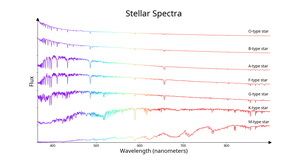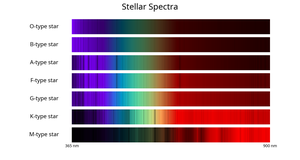Glossarbegriffe: Spektralklasse
Description: Sterne werden nach dem nach dem Aussehen ihres Lichtspektrums in Spektralklassen eingeteilt.
Bei den meisten Sternen basiert der Spektraltyp in erster Linie auf der Temperatur der Sternoberfläche und folgt einer Reihenfolge: O, B, A, F, G, K und M, vom heißesten zum kältesten. Diese Abfolge wurde kürzlich um die kühleren Typen L, T und Y erweitert. Diese drei Typen repräsentieren hauptsächlich braune Zwerge, aber einige Objekte mit dem Spektraltyp L sind eher Sterne als braune Zwerge.
Es gibt auch Buchstaben zur Klassifizierung spezieller Sternklassen. Kohlenstoffsterne sind Sterne mit starken Merkmalen in ihrem Lichtspektrum, die von kohlenstoffhaltigen Molekülen herrühren. Diese werden als Typ C klassifiziert. Sterne vom Typ S liegen zwischen den Typen K oder M und C, bei denen es nahezu gleich viel Kohlenstoff und Sauerstoff in der Atmosphäre gibt. Weiße Zwerge werden aufgrund von Merkmalen in ihren Spektren in eine Reihe verschiedener Spektraltypen eingeteilt, die alle mit dem Buchstaben D beginnen (DA, DB usw.). Für heiße, massereiche Sterne mit breiten Emissionslinien gibt es eine Reihe von Typen, die mit W beginnen (WN, WC, WO).
Die heutigen Spektraltypen basieren auf dem ersten modernen Klassifizierungsversuch, der am Harvard College Observatory unternommen wurde. Die ursprünglich alphabetisch mit A-Q bezeichneten Spektralklassen wurden später als Temperaturfolge neu geordnet, was zu den heute noch verwendeten Haupttypen führte. Die Hauptspektralklassen sind weiter in Unterklassen von 0 bis 9 unterteilt. Die Sonne gehört zum Spektraltyp G2.
Zusätzliche Buchstaben bei einer Angabe des Spektraltyps weisen auf besondere Merkmale hin (z. B. e für Sterne mit hellen Emissionslinien). Die Leuchtkraftklasse, die mit römischen Ziffern angegeben wird, kann ebenfalls angegeben werden.
Zugehörige Glossarbegriffe:
See this term in other languages
Term and definition status: The original definition of this term in English have been approved by a research astronomer and a teacher The translation of this term and its definition is still awaiting approval
The OAE Multilingual Glossary is a project of the IAU Office of Astronomy for Education (OAE) in collaboration with the IAU Office of Astronomy Outreach (OAO). The terms and definitions were chosen, written and reviewed by a collective effort from the OAE, the OAE Centers and Nodes, the OAE National Astronomy Education Coordinators (NAECs) and other volunteers. You can find a full list of credits here. All glossary terms and their definitions are released under a Creative Commons CC BY-4.0 license and should be credited to "IAU OAE".
Related Diagrams
Stellar spectral types
Bildnachweis: IAU OAE/SDSS/Niall Deacon
License: CC-BY-4.0 Creative Commons Namensnennung 4.0 International (CC BY 4.0) icons
Stellar spectral types - bands
Bildnachweis: IAU OAE/SDSS/Niall Deacon
License: CC-BY-4.0 Creative Commons Namensnennung 4.0 International (CC BY 4.0) icons










